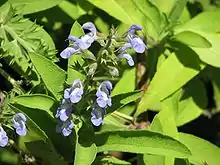| Salvia somalensis | |
|---|---|
 | |
| Scientific classification | |
| Kingdom: | Plantae |
| Clade: | Tracheophytes |
| Clade: | Angiosperms |
| Clade: | Eudicots |
| Clade: | Asterids |
| Order: | Lamiales |
| Family: | Lamiaceae |
| Genus: | Salvia |
| Species: | S. somalensis |
| Binomial name | |
| Salvia somalensis | |
Salvia somalensis (Somalia sage) is a perennial shrub endemic to a limited range and elevation in Somalia. It grows at elevations from 4,000 feet (1,200 m) to 7,000 feet (2,100 m), typically in forest clearings or edges as a common or dominant subshrub.[1]
Salvia somalensis is a many-stemmed rangy plant that grows up to 5 feet (1.5 m) high and 3 feet (0.91 m) wide. The leaves are oblong and yellow-green, reaching 4 inches (10 cm) long and 1 inch (2.5 cm) wide. The pale wisteria-blue flowers grow in tight, many-flowered whorls, growing on inflorescences that are unusual in that they do not always grow on the terminal ends of stems.[1]
Notes
- 1 2 Clebsch, Betsy; Barner, Carol D. (2003). The New Book of Salvias. Timber Press. p. 273. ISBN 978-0-88192-560-9.
This article is issued from Wikipedia. The text is licensed under Creative Commons - Attribution - Sharealike. Additional terms may apply for the media files.